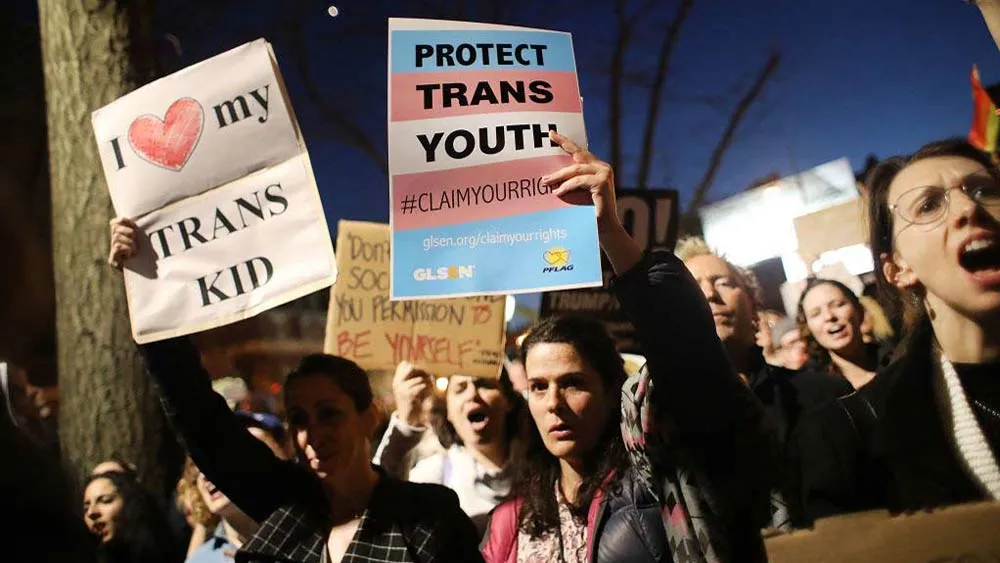September 24, 2021
Is the Future of Drag in Denmark?
Ivan Quintanilla READ TIME: 5 MIN.
"RuPaul's Drag Race" and its namesake host took home more historic Emmy Awards this week, and fans are gearing up for season three of "RuPaul's Drag Race UK." But Denmark's drag queens are making their own unique mark – one lip-synch, comedy show and drag bingo at a time.
Seven international "Drag Race" editions have exploded the art form into a global phenomenon, inspiring queens all over the world and increasing RuPaul's net worth to a reported $65 million. Though many up-and-coming drag queens would love to be a "Ru girl," a unique drag identity is emerging from Denmark's capital of Copenhagen. Here, the scene fuses performance and activism, and is surprisingly diverse for a city of 600,000.
"The Copenhagen drag scene is thriving these years. I don't think it's ever been as happening as it is right now," says Chantal Al Arab, the Copenhagen queen who "by day" moonlights as Anders Larsen, an author, historian and lecturer of cultural history at the Danish Institute of Study Abroad. "What I really love about the Copenhagen scene is that apart from our standard, template drags – you know the cinched, padded, 'yaaas honey, yaaas mama,' heels and big hair – we also have a lot of different kinds of drag."
Coinciding with Copenhagen 2021, when the city hosted World Pride and EuroGames this past August, Anders co-curated "Bearded Queens of Copenhagen. The Library is Open. Officially" at the Royal Danish Academy Library. The exhibition paid tribute to three of the city's most popular bearded drag queens: Brynhildr, Maj Mokaj and Jaxie. Through images, video and their own words, it celebrated "how the queens advocate for inclusion, diversity and gender equality," according to the exhibition description.
The fusion of fierce activism with follicles is not a new phenomenon in Copenhagen. In the 1970s, the Gay Liberation Front movement, one of the country's most influential LGBTQ+ activist organizations, marched in the streets wearing dresses, wigs and beards to demand rights and challenge heteronormative society.
The tradition continues. "A few years back, I started moderating at Copenhagen Pride, and I think I've found my little niche. Activism but in drag – that's where I thrive the best," says Chantal. "It's also about realizing that when you are in drag, you command a gaze. And I think many drag queens in Copenhagen realize that. You have people's attention, so you shouldn't waste it."
Mizz Privileze, another popular queen (who sports a mustache and does a fabulous Freddie Mercury in addition to her drag), started an anti-hate crime campaign where she collected a thousand stories of hate crimes and delivered them to members of Parliament.
Drag has also woven itself into the cultural fabric of Copenhagen. Every year, "Drag Night" is one of the marquee events of Copenhagen Pride and has grown to be one of the largest drag shows in the world, according to Tonny Liljenberg, organizer of the event since 2014. In 2019, the last show before Covid restrictions, Liljenberg estimates 20,000 people of all orientations were cheering in City Hall Square, where the four-hour outdoor show performs.
Liljenberg also produces Draghouse four times a year at Vega, one of Copenhagen's most popular performance spaces. This year, they have incorporated a gender-neutral competition where any body of any expression – drag queen, drag king, non-binary – can compete. The two-hour show, which he describes as more of a concert akin to Eurovision, will next perform on September 25 and November 26.
For a more "American drag bar" experience, head to the recently reopened GAY Copenhagen on Thursday nights. Here, even though the crowd and queens tend to be younger and the performance style steers toward traditional lip-syncs, they are still breaking new ground, according to Chantal.
"I will say that the queens you see at GAY are a lot more diverse than what you see on 'RuPaul's Drag Race.' They've had trans performers, bio queens, bio kings – all much longer than what we've seen on 'Drag Race.' So I'd say they've been ahead of the curve."
Humor is also a popular component of Copenhagen drag. "Drag bingo is a big thing here," says Liljenberg. Comedy Zoo, a non-LGBTQ+ club, regularly features drag queens for comedy sets and bingo. "You don't just find us in queer spaces," says Chantal. "We have taken over the city: canal tours, community centers, comedy clubs and national television. We are everywhere."
Also, the economic realities of Denmark are different than in other countries. "I think the performers are quite privileged here in the way that it's not a matter of life and death, it's not a matter of making a living or putting food on the table by performing. And that's because of our social system. So, it's not as cutthroat," says Liljenberg.
"Overall, I would say the drag scene in Copenhagen is extremely playful. It's about playing with categories such as gender, identity, age. There's a lot of awareness of categories as boxes you can move between and that you can dissolve and play around with. Jaxie travels across species. Sometimes she's a German Easter Bunny, and other times she's an alien," says Chantal. "I would say most performers work in multiple mediums. It's not enough to just stand on stage; it takes more to impress Copenhageners."
Cuban born, Miami raised, Dallas and London educated and New York seasoned, Ivan Quintanilla is a travel writer and professional actor living in Hell's Kitchen, NYC. Read about his latest destinations at TravelingIQ and follow him on Instagram at @TravelingIQ


